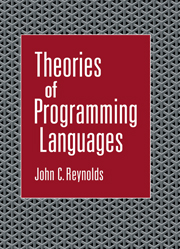Book contents
- Frontmatter
- Contents
- Preface
- 1 Predicate Logic
- 2 The Simple Imperative Language
- 3 Program Specifications and Their Proofs
- 4 Arrays
- 5 Failure, Input-Output, and Continuations
- 6 Transition Semantics
- 7 Nondeterminism and Guarded Commands
- 8 Shared-Variable Concurrency
- 9 Communicating Sequential Processes
- 10 The Lambda Calculus
- 11 An Eager Functional Language
- 12 Continuations in a Functional Language
- 13 Iswim-like Languages
- 14 A Normal-Order Language
- 15 The Simple Type System
- 16 Subtypes and Intersection Types
- 17 Polymorphism
- 18 Module Specification
- 19 Algol-like Languages
- Appendix: Mathematical Background
- Bibliography
- Index
Appendix: Mathematical Background
Published online by Cambridge University Press: 28 January 2010
- Frontmatter
- Contents
- Preface
- 1 Predicate Logic
- 2 The Simple Imperative Language
- 3 Program Specifications and Their Proofs
- 4 Arrays
- 5 Failure, Input-Output, and Continuations
- 6 Transition Semantics
- 7 Nondeterminism and Guarded Commands
- 8 Shared-Variable Concurrency
- 9 Communicating Sequential Processes
- 10 The Lambda Calculus
- 11 An Eager Functional Language
- 12 Continuations in a Functional Language
- 13 Iswim-like Languages
- 14 A Normal-Order Language
- 15 The Simple Type System
- 16 Subtypes and Intersection Types
- 17 Polymorphism
- 18 Module Specification
- 19 Algol-like Languages
- Appendix: Mathematical Background
- Bibliography
- Index
Summary
Here we describe a variety of general mathematical concepts and notations that are used in this book. (Concepts that are more advanced, or are particular to programming-language theory, are explained in the main text when they are first used.) Even though most of these concepts may be familiar, readers are advised to scan this material, especially since some of the notations are novel.
In fact, modern mathematics gives the writer a surprising degree of freedom in defining its fundamental concepts, as long as the definitions are consistent and lead to entities with appropriate properties. In this book, I have made the following choices:
Pairs are taken to be a primitive notion rather than being defined in terms of sets.
Relations are defined as sets of pairs, functions as a special kind of relation, sequences as a special kind of function, and pairs as a special kind of sequence. Since a pair, however, cannot be a set containing itself, we break the inconsistent circle by distinguishing between the pairs 〈x,y) that are sequences and the primitive pairs [x,y] that are members of relations.
We define relations (including functions) to be sets of primitive argument-result pairs, rather than calling such a set the “graph” of the relation and defining the relation itself to consist of a domain, a codomain, and a graph. Thus, for example, the function on the integers that increases its argument by one is both a function from integers to integers and a function from integers to reals, and also a partial function from reals to reals. (This view of functions is taken by Gleason [1966, Sections 3–4.1 to 3–4.11]. It is a special case of the view that, in category theory, the morphism sets of a category need not be disjoint.)
[…]
- Type
- Chapter
- Information
- Theories of Programming Languages , pp. 447 - 466Publisher: Cambridge University PressPrint publication year: 1998



